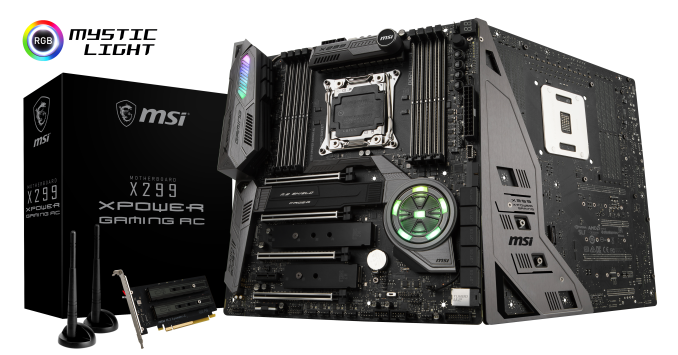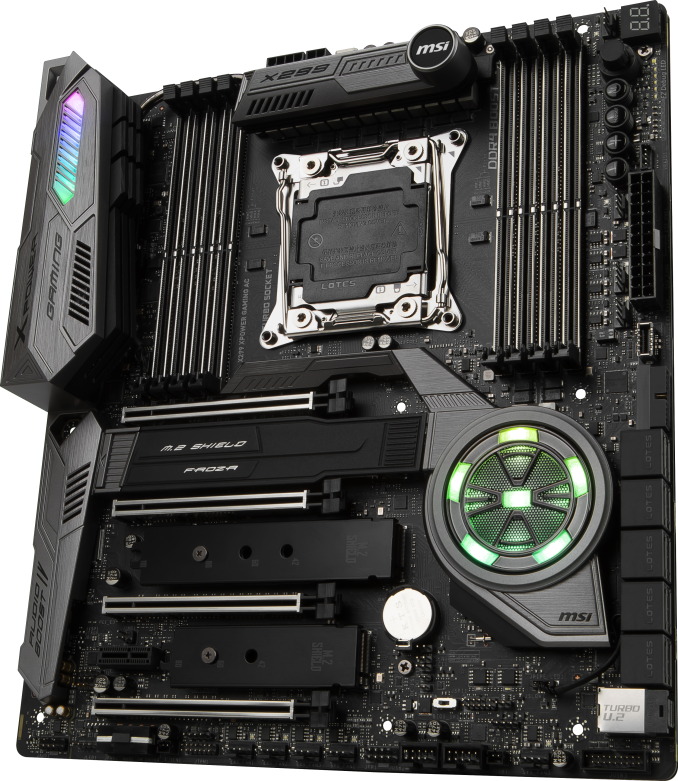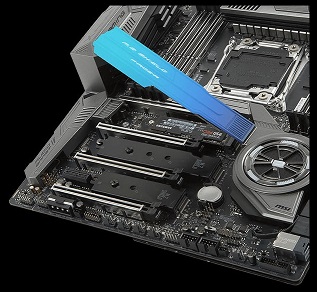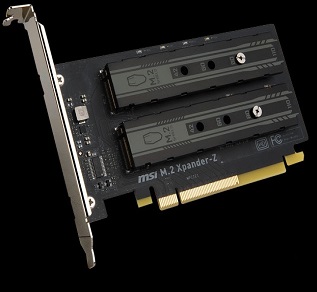MSI Announces the X299 XPower Gaming AC Motherboard: Five M.2 Slots
by Joe Shields on July 12, 2017 11:00 AM EST- Posted in
- Motherboards
- Gaming
- MSI
- X299
- Skylake-X
- Kaby Lake-X
- XPower
- XPower Gaming AC

This week MSI has announced a new X299 motherboard: the MSI X299 XPOWER GAMING AC. This is designed as a flagship motherboard for MSI's X299 range, and aims to combine gaming features and performance with the overclocking pedigree of their XPower family from previous generations.
One thing that may jump out is MSI is adjusting its aesthetic scheme and returning back to a more neutral black on the XPower, a deviation from the recent generations where the XPower would get a 'titanium' silver treatment (or even older generations of XPower that were yellow). The theme agnostic color choice is due to the prevalence of RGB LEDs, found on both the “reactor” design of the chipset heatsink as well as above the I/O area on the shroud. The basic premise is that having customizable RGB LEDs should allow the motherboard to fit into more customized and themed builds, whereas some of the previous color designs may have pigeon-holed the design of systems. To contrast the dark color scheme, MSI has used their branded 'Steel Armor' protective coverings for the x16 PCIe slots, as well as the DIMM slots and the U.2 connector.
For the X299 XPower Gaming AC, MSI uses a 14 phase power design which is claimed to help heavy overclocking, combined with a joined VRM and IO heatsink. MSI likes to promote the use of 'Military Class' components for the power delivery and other features, and claims that their use of isolated memory circuits that use optimized routing (to ensure optimal signals to and from the CPU and RAM) will allow each motherboard to reach DDR4-5000 or higher depending on the CPU memory controller, although they do not state on what cooling (likely, sub-zero).
One of the key features for this board will be the M.2 support. MSI is directly supporting three drives on board, but has also bundled a riser card for two more. For the onboard slots, MSI is using its new heatsink, the M.2 Shield Frozr. For the top M.2 slot, the heatsink is connected to the PCH heatsink in order to help move heat away. The bundled PCIe riser card is called MSI's XPander-Z, for M.2 slot expansion. This add-in-card gives a PCIe 3.0 x8 connection, and allows the user to mount two additional 110mm PCIe 3.0 x4 M.2 drives on it, giving the board a total of five M.2 slots. The expansion card setup supports Intel VROC technology, allowing a RAID-0 configuration directly from the CPU bypassing the typical throughput limits of PCIe 3.0 x4 slots.
Moving more towards the connectivity, the XPower features two Intel Gigabit LAN ports (Intel I219V and Intel I211), an 802.11ac 2x2 WiFi card, and a Realtek ALC1220 audio codec. MSI likes to promote its use of advanced audio design options, such as EMI shielding, PCB separation, corrosion resistant audio connectors, and bundled software. MSI also bundles traffic shaping software for the networking.
MSI used the ASMedia ASM3142 controller to deliver two USB 3.1 Gen2 ports, including a front panel header. They claim to have worked closely with several case manufacturers for product testing to ensure they are compatible with any MSI X299 motherboard. We've not particularly approached the ASM3142 controller in detail on AnandTech yet, but it represents a more power efficient variant of the ASM2142, which in turn is a dual-bandwidth version of the ASM1142, the first dual-port USB 3.1 (10 Gbps) controller we found on motherboards.
At the time of this writing, pricing and availability were not available.
Related Reading
Source: MSI




















25 Comments
View All Comments
HardCore - Wednesday, July 12, 2017 - link
Well, if you look at the backplate designs on MSI's previous Z170 MPower Titanium and Z270 MPower Titanium, along with Gigabyte's X299 Gaming 9 (which I mentioned in my original post), they all reinforce close to the CPU socket area, while still being totally accessible from the underside.And the GPU segment is already using metal sockets on MSI's Z270 MPower Titanium and Gigabyte's X299 Gaming 9, but the reinforcing backplate underneath those PCIe slots still helps to prevent any slight flexing of the mobo due to really heavy GPUs. I have two MSI GTX 1080 Ti Gaming X GPUs in 2-way SLI, and all the third-party 1080 Ti GPUs are big, fat, and heavy. The issue is not the reinforced PCIe sockets themselves, but the torsional strain on the mobo area around the sockets exerted by heavy GPUs.
The RAM banks do not exert any weight burden, even with 8 big-finned XMPed RAM sticks. I like the backplate on the Z270 MPower Titanium and Gigabyte's X299 Gaming 9 far better. But this X299 XPower Gaming AC's 12+1+1 phase power design is far better than Gigabyte's 8+1+1 that they use on their top-of-the-line X299 Gaming 9. I have MSI's excellent Z270 XPower Gaming Titanium (not their Z270 MPower with the backplate), and it has a very robust 14+1+1 phase VRM design, along with the extra 8-pin CPU/EPS connector, and an extra on-board 6-pin PCIe connector for adding more power to the PCIe slots. In several ways, that Z270 XPower Gaming Titanium beats any X299 mobo released so far, including this X299 XPower.
HomeworldFound - Wednesday, July 12, 2017 - link
True, well there are only so many guesses and judgements you can make from a set of pictures. The ram banks are metal reinforced too but sometimes a bit more pressure is required just to get the clips to lock.I'm currently on the X99A XPOWER GAMING TITANIUM board. It was very expensive, much more than I'd normally be willing to pay. I'd say MSI has gotten better since the days of the P67A.
HomeworldFound - Wednesday, July 12, 2017 - link
Taking another look, you're right. The end of the ram-banks that could be reinforced definitely aren't. I do wish I got to handle more hardware but life is just not what I wanted it to be.HomeworldFound - Wednesday, July 12, 2017 - link
Apart from the UFO that's a really sexy board.HardCore - Wednesday, July 12, 2017 - link
Umm, the obvious inspiration for that design is the Iron Man Arc Reactor. MSI even refers to it as "XPower Reactor with Mystic Light" on their product page. But they obviously could not exactly copy the Arc Reactor pattern without either paying royalties to Marvel Comics or stepping onto trademark infringement. I wish they used an RGB MSI dragon logo on the PCH, like what they used on their X299 M7 and previous X370, Z270, Z170, and X99A XPower mobos.